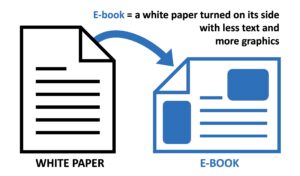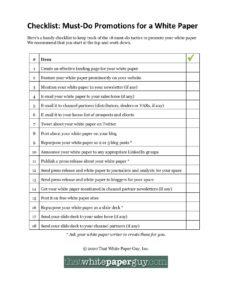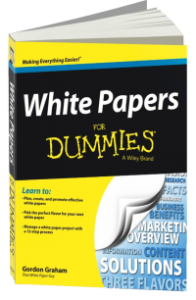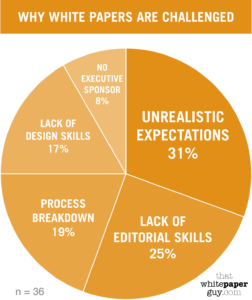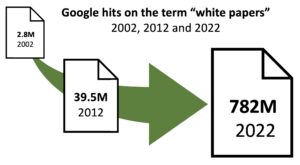White Paper FAQ (Frequently Asked Questions)
When I first started writing white papers 25 years ago, I looked all over for a FAQ.
When I couldn’t find one, I decided to write one myself.

Over the years, I’ve kept adding to it, until today when it covers 36 questions.
This is undoubtedly the most detailed, most thorough FAQ on white papers anywhere.
Whether you’re a B2B marketer or writer, I hope it helps you understand white papers better.
White Paper FAQ topics
Click any topic to see related questions and answers.
White paper definitions
White papers compared to other documents
White paper readers
White paper sponsors
White paper writers
White paper success and failure
White papers past, present, and future
White paper definitions
- What exactly is a white paper?
- Are there any industry standards for these?
- Aren’t there at least some conventions?
- What different types of white papers exist?
- Can you combine different types?
- What’s the maximum number of points in a numbered list?
- What if your idea doesn’t fit any of the flavors?
- When is each type of white paper most useful?
- What’s NOT a white paper?
White papers compared to other documents
- White papers and blog posts: What’s the difference?
- White papers and brochures: What’s the diff?
- White papers and case studies: What’s the diff?
- White papers and ebooks: What’s the diff?
- White papers and press releases: What’s the diff?
White paper readers
- Who reads white papers?
- Why do people read white papers?
- Where do people read white papers?
- When do people read white papers?
- How do people read white papers?
White paper sponsors
- Who publishes white papers?
- Why do companies produce white papers?
- Where do white papers fit in the sales cycle?
- Which type of white paper should your firm create?
- How much does a white paper cost?
- How long does a white paper take?
- How do you promote a white paper?
White paper writers
- What kind of companies need white papers?
- How hard is it to write a white paper?
- How long should a white paper be?
- How long does it take to write a white paper?
- How much can you charge to write a white paper?
- What main problems do white paper writers encounter?
- How can you learn more about white papers?
- Where do you find white paper clients?
White paper fails
White papers past, present, and future
- Where did white papers come from?
- Where are white papers today?
- Where are white papers going in the future?
- Won’t all white paper writers soon be replaced by AI?
White paper definitions
What exactly is a white paper?
Ask any 10 people this question, and you’ll likely get 12 different answers.
Here is the best short definition I’ve ever found, after years of looking:
A white paper is a persuasive essay that uses facts and logic to promote a certain product, service, or viewpoint.

Beyond that, I’ve heard a white paper described as:
• A manifesto on how to solve a certain problem
• A bait-piece
• The glue that holds a campaign together
• An information widget
• A way to freeze-dry your ideas
• The magic Excalibur of marketing!
Clearly, none of these exotic definitions do the trick.
For some better clues, look at the content and format of these documents:
The content of a white paper provides useful information for business people seeking to understand an issue, solve a problem, or make a decision.
The format of a white paper is somewhere between a technical manual and a glossy brochure… between a dry-as-dust academic paper and a colorful annual report.
Some good models are respected magazines/websites like Scientific American or The Economist. Like the best white papers, these publications explain scientific and financial information in a visually appealing way.

Are there any industry standards for these documents?
In a word, no.
Everything from a two-page flyer to a 100-page book has been called a white paper.
There are even “video white papers.” This seems like an oxymoron. How can a video be a paper?
But there are no fixed rules to define a white paper, and no one to enforce them if there were.
If there are no standards, aren’t there at least some conventions?
Well, perhaps.
That White Paper Guy aka Gordon Graham has identified these key characteristics for a white paper:
- A document containing narrative text
- At least 5-6 pages long (2,500+ words)
- Portrait format (landscape tends to be for ebooks)
- Educational, practical, useful information, not a sales pitch
- Used before not after a sale (info after a sale is documentation)
- Provides facts not just opinion
- Includes an introduction or executive summary at the start
- Includes a call-to-action (CTA) at the end
If a document has all these characteristics, it’s probably a white paper.
To elaborate, the main body of a “typical” white paper is 6 to 8 pages long, shorter than in past years. With front matter and back matter, the total length is usually 10 to 12 pages.
What different types of white papers exist?
White papers come in many different types, with no universal system for labeling them precisely.
Given this, the majority of white papers fall into one of these three types:
1. A backgrounder describes the technical features and benefits of a product or service
2. A numbered list provides a light and lively set of points or concerns about some topic
3. A problem/solution recommends a new, improved solution for a nagging business or technical problem
About 15 years ago, That White Paper Guy proposed that these three types could be remembered as different flavors of ice cream.
Backgrounder = vanilla: old-fashioned and predictable
Numbered list = strawberry: light and lively
Problem/solution = chocolate: deep, rich and long-lasting



For more on these three flavors and how to use them effectively, see my free infographic.
Beyond these, many other terms are commonly used to describe white papers:
- Competitive review
- Evaluator’s guide
- Executive briefing
- Market overview
- Position paper
- Product briefing
- Special report
But all these descriptive terms fit under one or another of the three main types, so these terms are not as helpful.
Can you combine different types of white papers?
Yes. You can combine two of these three flavors like so:
- Numbered list + backgrounder (strawberry + vanilla)
- Numbered list + problem/solution (strawberry + chocolate)
This yields five main flavors of white papers in all: three “pure” and two “mashups.”

A numbered list + backgrounder (strawberry + vanilla) white paper looks at a number of elements or functions of a certain offering.
This kind of mashup promises an easy read and some useful information about a certain offering.
The title should start with a number and end with the product name.
For example:
— 3 Advanced Security Features of Acme Scanomatic 3000
— 5 Hidden Gotchas of Windows 12
— 6 Things You Should Know about Web3
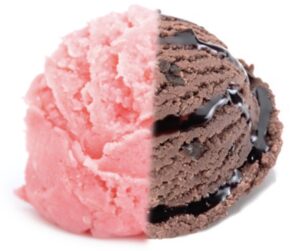
A numbered list + problem/solution (strawberry + chocolate) white paper covers three different aspects of some industry-wide problem.
This kind of mashup promises an easy read along with some deep insight into a nagging industry problem.
The title should start with a number and end with the problem/solution.
For example:
— 3 Critical Challenges of Design/Build Projects and How to Solve Them
— 4 Pillars of Financial Inclusion and How Bill C-25 Strengthens Them
— 5 Backdoors that Let Hackers Steal Your IP and What to Do About Them
 The remaining type of mashup, a problem/solution and backgrounder, doesn’t work at all well.
The remaining type of mashup, a problem/solution and backgrounder, doesn’t work at all well.
That’s because these two have such different viewpoints.
A problem/solution is like looking at a wide view of a whole industry with a telescope.
A backgrounder is like zooming in on one specific offering with a microscope.
It’s difficult to combine both perspectives in the same document. Instead, it’s better to do two different white papers, one of each type.

In real life, Neapolitan ice cream is great. But don’t try this with white papers.
It’s almost impossible to describe both an industry-wide problem and a specific offering as numbered lists in the same document.
You’ll likely just make a mess.
It’s far better to do two different white papers of the appropriate flavors.
What’s the maximum number of points in a numbered list?
The benefit of a numbered list (aka listicle) is that it promises an easy read.
It sounds light and lively, just a collection of points or items that someone can scan through. So any list up to 9 sounds quick and easy.
Once you get up into the high teens—17, 18, 19—it sounds like a lot more work. And if you go to 20, 30, 40 or 50 items, that starts to sound overwhelming.
Remember why telephone numbers are given as 7 digits: That’s about the longest sequence of numbers most people can remember.
Then there’s the odd vs even quandary.
Odd numbers somehow seem more real than even numbers, which can appear too “neat” or “rounded off.”
That’s why many people believe that a listicle with 3, 5, 7 or 9 items will be downloaded more than one with 4, 6 or 8.
The worse culprit is probably a list of 10, because it sounds so much like a “top 10 list” and everyone knows it was probably padded out to get to 10.
When is each type of white paper most useful?
Each type is best for delivering information to prospects at a certain point in their customer journey, as shown below.
For shorthand, “offering” means any product, service, technology, or methodology described in the white paper.
For the three main flavors and two mashups of white paper:
1. Backgrounder: Best for prospects evaluating a shortlist of offerings near the end of the customer journey; also best to support a product launch for journalists, analysts, and channel partners
2. Numbered list: Best to nurture prospects in the middle of the customer journey with a light and lively roundup of points about some topic; also good for spreading fear, uncertainty, and doubt (FUD) about competitors
3. Problem/solution white paper: Best to draw in new prospects at the start of the customer journey as they research a nagging business or technical problem
A numbered list + problem/solution is best in the early half of the customer journey, while the prospect is interested in finding new solutions to their nagging business problem.
A numbered list + backgrounder is best in the later half of the customer journey, while the prospect is starting to dive deeper in the details of the offerings on their shortlist.
What if your idea doesn’t fit any of the flavors?
These three flavors will likely cover 4 out of 5 of the white papers you see. I call that the 3-4-5 rule.
But what about those outliers, the other 1 out of 5 that just doesn’t fit any flavor?
- What about the results of a survey?
- A history of how a certain technology was developed?
- A day-in-the-life of a business executive?
I’ve written white papers about all those topics.

Captain Barbossa
My best advice is not to sweat it.
The three flavors aren’t iron-clad categories. No one is policing the marketing world to make sure you follow them.
These are intended as useful templates to help frame a white paper in the planning stages, to help decide what to put in and what to leave out.
And to paraphrase Captain Barbossa from the Pirates of the Caribbean, the three flavors are more what you’d call “guidelines.”
You can create a white paper on any topic, for any audience, using any approach under the sun, as long as you remember this key mantra:
A truly effective white paper helps a business person understand an issue, solve a problem, or make a decision.
If you content does that, your readers will thank you. And they won’t give a hoot what flavor you call it… or even if you call it a “white paper” at all.
What’s NOT a white paper?
Remember that there are no “rules” or universal standards for what makes a white paper… and that means many people use this label very carelessly.
By my definition, a white paper is intended to help a business person understand an issue, solve a problem, or make a decision.
There are many other types of useful information, but I don’t consider those white papers.
For example, marketing guru Perry Marshall names 40+ documents that he considers to be white papers, including:

• Application guide
• Cheat sheet
• Installation guide
• Manual (?!)
• Optimizer
• Pocket guide
• Troubleshooting guide
• Tutorial
But notice how many of these are actually documentation used after a B2B purchase when installing, learning, or troubleshooting a system.
Those may be useful, but they’re not white papers.
To my thinking, a white paper is strictly a pre-sales document used before a B2B purchase. It’s not documentation or support, it’s sales and marketing.
For a longer discussion, see my article “When is a white paper NOT a white paper.”
White papers compared to other documents
White papers and blog posts: What’s the difference?
White papers and blog posts are usually quite simple to tell apart.
White papers are usually PDF downloads of 3,000 to 5,000 words.
A good white paper is based on established facts and logical arguments, like a well-researched article in an industry journal.
A white paper generally takes 4 to 6 weeks of intense effort by a group of people. That’s why an effective white paper can be used for a year or two.
Blog posts are usually much shorter web pages of 600 to 1,800 words. A blog post can often be written in a couple of hours.
A blog post can be sheer opinion, or even a rant, more like a letter to the editor. That’s why there are so many blogs: Anyone can shoot off their mouth in a blog.
That’s why most blog posts are relevant for only a few months.
In a way, blog posts are a good place to test out your ideas, as they come together. You can gather comments and feedback, and see how your audience connects with your ideas.
Then you can solidify and back up your ideas in a white paper where you can pour more time and effort into the research, writing, design, and promotion.
White papers and brochures: What’s the difference?
White papers and brochures are almost complete opposites.
Brochures are sales documents intended to create interest and desire.
Today brochures are most often used in B2C for major purchases like cars, trucks, and boats.
They use the techniques of copywriting and advertising. They tend to push “emotional buttons” such as fear, greed, envy, or vanity.
Brochures are generally designed to be scanned: colorful, flashy, and filled with short snippets of text.
White papers, on the other hand, are persuasive essays about a certain product, service, technology, or methodology.
White papers are most often used in B2B for offerings that are relatively new, complex, or expensive.
They use the techniques of rhetoric and plain English. They tend to appeal more to logic through irrefutable facts, iron-clad logic, impeccable statistics, and quotes from industry opinion-makers.
White papers are generally designed to be read. They contain lots of text and some graphics, but not often a lot of pizzaz.
Some companies simply reformat a brochure and call the result a “white paper.” This is a waste of effort. Most readers become irritated when they see a vendor doing this.
Some marketers who should know better urge vendors to make white papers as flashy as brochures. This is not correct.
A white paper should be much more dignified, substantial, and informative than a brochure. Making it look like a sales piece is the kiss of death for a white paper.ny
White papers and case studies: What’s the difference?
White papers sometimes mention case studies for evidence of a vendor’s claims. But the two are quite different.
Case studies are extended testimonials on how a product or service helped someone in the real world. They are typically between 500 and 1,500 words long, written in a journalistic style with many quotes from the actual customer.
The classic format for a case study is Before/After, Then/Now, Problem/Solution:
Before we had this terrible problem, then we found this fantastic product, and After we started using it, everything was sweetness and light.
White papers, on the other hand, are persuasive essays about a certain product, service, technology, or methodology.
They are generally 3,000 words or more, written in a somewhat academic style, with no direct quotes from the vendor. A white paper may be told in the Problem/Solution format, but rarely in the Before/After format.
White papers tend to be used earlier in the sales cycle, to help prospects visualize a possible solution to a nagging problem.
Case studies tend to be used later in the sales cycle to reassure a prospect that other buyers benefited from the same approach they are considering.
For a longer discussion, see my article “White papers versus case studies.”
White papers and ebooks: What’s the difference?
Remember, we’re talking here about ebooks used in B2B content marketing.
A B2B ebook can be hard to tell apart from a white paper. You can often call the very same document either a white paper or an ebook.
In recent surveys, the Content Marketing Institute has grouped white papers and ebooks into one category. And why not?
A B2B ebook can be just about any length on just about any topic.
Many ebooks look more like slide decks than text-driven documents.
Some say ebooks are just prettied-up white papers turned on their sides, with more graphics and less text.
In any case, here are some scenarios when an ebook might work better than a white paper:
1: Your audience is prone to distraction
They may be young or very mobile. An ebook may sound like fun, while a white paper sounds like work.
2: Many competitors publish white papers
If you’re trying to break through the noise of competing white papers, an ebook might sound different enough to be engaging.
You may be able to gain more traction by presenting the same content as an ebook instead of a white paper.
3: No one in your industry publishes white papers
In some industries, white papers are not often seen.
In that case, your document may work better if you call it something else, perhaps a “special report” or “briefing.”
Just remember: The goal is the same.
An ideal ebook—just like an ideal white paper—will help your target audience understand an issue, solve a problem, or make a decision.
If your content does that, you can call it an ebook, white paper, special report, or whatever… and your audience will still thank you for it.
White papers and press releases: What’s the difference?
Press releases are short, factual announcements of interest to a certain audience. This format has existed for perhaps 100 years.
Until recently, press releases were used to influence media “gatekeepers” and gain publicity for their sponsor. The most effective press releases were recycled by journalists into printed articles.
Today, press releases are available to anyone on the Web, without the need for any gatekeeper.
A contemporary press release must be highly factual. Unlike for white papers, there are rules about what a public company can say in a press release.
White papers, on the other hand, are persuasive essays about a certain product, service, technology, or methodology.
White papers have also existed for 100 years, although the format evolved quickly since the year 2000.
While a white paper is sponsored by a company—the same as a press release—white papers are generally much longer than press releases, with more room to present facts and develop arguments.
White papers are sometimes packaged with press releases as a “press kit.” And they are sometimes republished in trade magazines as articles.
On the Web, white papers are available to almost everyone. There are no special legal rules on what a company can say in a white paper.
But it’s best to take a journalistic approach, backing up every assertion with statistics, facts, and quotes from respected sources.
White paper readers
Who reads white papers?
White papers are read by almost any B2B executive who is thinking about buying a relatively new, relatively complex, or relatively high-priced product or service for their business.
White paper readers play many different roles in business, such as:
- Corporate executives (decision-makers)
- Finance executives (financial recommenders)
- IT managers and staff (technical recommenders)
- Line-of-business managers (managers)
- User representatives (users)
- In-house supporters of the purchase (“champions”)
In larger companies, all these people may sit together on a selection committee that makes a collective decision.
In smaller firms, some people may wear several of these hats and meet informally to discuss any big purchases.
White papers are especially well-read by IT managers.
One survey showed that they read a median of 30 white papers a year, with some reading more than 50 a year… that’s one a week!
As well, business people routinely pass good white papers up and down the chain of command, both to their managers and their staff.

Why do people read white papers?
White paper readers are seeking useful information to help them understand an issue, solve a problem, or make a decision.
This often involves learning about the business benefits or technical details of a product or service they are considering buying.
A survey of IT managers by Forbes.com and Bitpipe (now TechTarget) showed that they read white papers to accomplish these goals:
- Stay on top of new trends (76%)
- Get information about products and vendors (69%)
- Compare products (50%)
- Help justify buying decisions (42%)
- Develop a shortlist of qualified vendors (33%).
White papers used to be aimed strictly at IT professionals.
Today, many less technical people are involved in B2B buying decisions.
These people are seeking plain-language explanations with clear business benefits, backed up by convincing facts and arguments.
Where do people read white papers?
You’ve likely heard that everything on the web should be designed mobile-first.
When it comes to white papers, this is bad advice.
Research into content consumption shows that long-form B2B content is usually viewed on larger screens.
Several studies show that nearly everyone (90%) reads white papers on desktop screens, not mobile devices.
White papers are occasionally (10%) printed for sales calls, press kits, and trade shows.
And some people read them on paper during their commutes by subway or train.
So make sure to write for the screen, and then design for the screen—but a larger screen, not some dinky smartphone screen.
After all, B2B buyers with a problem to solve aren’t often doing their research while they’re rushing around in the field.
B2B buyers do their research in their offices with their big-screen desktops.
When do people read white papers?
People tend to read white papers when they are:
- Dreaming of a way around a pressing problem
- Wondering if anything could solve their problem
- Looking for something to satisfy their wishlist
- Researching a possible purchase
- Drawing up a shortlist of qualified vendors
Executives at the IT portal KnowledgeStorm (now TechTarget) encourage clients to think of a technology sale in four phases.
1. Vision: A business person is imagining how to solve a problem. At that point, a high-level white paper focused on business benefits can help them visualize the possibilities of a certain offering.
2. Planning: A prospect is trying to map a set of functional requirements to a certain product. That’s when a more detailed, technical white paper can help them understand how a given solution would work in their environment.
3. Evaluation: A prospect is actively looking at a set of products from a shortlist of vendors. The need for white papers has pretty much passed.
An Evaluator’s Guide for a complex product might be helpful at this point. But more often, prospects want the reassurance of seeing case studies from other customers.
4. Acquisition: A customer is actually purchasing and installing a product. They may need added information to help them do so, but it’s more accurate to call this “documentation” rather than a white paper.
After all, the white paper has already played its role and the sale has already been made. Everything from this point on is after-sales support.
How do people read white papers?
B2B executives have more to read, more to remember, and more to do than they can ever get to.
For example, one study showed that the typical manager has more than 50 hours of work sitting on their desk at any point.
They’re frazzled, distracted, and interrupted from all directions. No one is waiting for yet another document to add to their pile?!
No one reads white papers for fun; they read them for work.
So people who read white papers don’t read the same way they might read a novel, paying attention to every sentence.
They tend to skim, scan, and skip… especially when reading off the screen. Don’t you?
This means that white papers must be written and designed for business readers with limited time and attention.
A wall of gray text will not engage anyone today.
To hold and direct the attention of skimmers and scanners, white papers need visual breakers like boxes, bullets, graphics, headings, pull-quotes, and sidebars.
These visuals must point to the key messages of the document in a way that’s easy for busy readers to follow.
If your white paper is crisp, helpful, and easy on the eyes, they will spend some time with it.
If not, they will quickly click away to something more pressing.
For a longer discussion of white paper design, see my article “20 top tips on white paper design.”
Who publishes white papers?
White papers abound in the technology sector, where they are commonly used to explain software and hardware products.
But there’s no reason why white papers can’t be written about many other B2B offerings.
Any B2B vendor selling anything relatively new, relatively complex, or relatively expensive could likely benefit from a white paper.
This includes companies in sectors like these:
- Computer peripherals
- Consulting firms with new methods
- Medical devices or diagnostic equipment
- Technical or scientific services
- Test or communication equipment
- Training firms with innovative approaches
This adds up to perhaps half a million potential vendors in the English-speaking world that could benefit from white papers.
Vendors of any relatively familiar, simple, and inexpensive consumer products don’t often publish white papers, since there is little need for them in B2C marketing.
After all, most consumers don’t want to read a 10-page document before they buy something.
There may be exceptions—such as energy, investments, and healthcare—where consumers may have to make considered purchases. But these exceptions are few and far between.
Video, social media, and sales pages tend to work better for B2C sales.
Why do companies produce white papers?
B2B vendors publish white papers for many reasons:
- To generate leads
- To support a new product launch
- To educate analysts, bloggers, and journalists
- To educate their own sales force and channel partners
- To nurture prospects through a complex B2B sale
- To win in a technical evaluation against competitors
- To redefine a marketing space
- To stake out a position as a leader in their space
On a strategic level, white papers fit into the widespread trend of content marketing.
Content marketing is based on the belief that skeptical prospects are hungry for a vendor who will serve as a trusted advisor, not just a peddler of their wares.
A white paper can serve this purpose remarkably well.
Remember, a good white paper is more than just background about a product.
The most effective white papers provide useful information to help a business reader understand an issue, solve a problem, or make a decision.
Where do white papers fit in the sales cycle?
The longer the sales cycle—aka customer journey—the more likely white papers are part of it.
White papers are used in the sales cycle before the prospect makes a purchase.
Different types of white papers work best at different points in the sales cycle:
- To attract fresh prospects at the start of the process (generating leads), the problem/solution or chocolate format works best
- To engage prospects through the middle of the process (nurturing prospects), the numbered list or strawberry flavor works best
- To encourage a purchase decision near the end of the process (support a technical evaluation), the backgrounder or vanilla flavor works best
After making a purchase, the buyer has little need for white papers.
At this point, the customer may need documentation, training, and technical support. They generally do not need any more white papers until an updated product is available, and they must decide whether to upgrade.
Which type of white paper should your firm create?
If you are creating a white paper, but aren’t sure which flavor is best, you can narrow down the list with three straightforward questions.
1: What is the purpose of this paper?
- Generate leads
- Attract attention
- Nurture prospects through a complex sale
- Cast FUD on competitors
- Influence a selection committee
The best flavors to generate leads at the start of the customer journey are a problem/solution or a numbered list + problem/solution.
In general, the best flavor to attract attention, to cast Fear, Uncertainty and Doubt (FUD) on competitors, or to nurture a prospect through a complex sale is a numbered list.
The best flavor to influence a selection committee near the end of the customer journey is a backgrounder.
2: When will this white paper be used?
Early in the sales cycle, your white paper can be more high-level and general.
Later on, your white paper should be more detailed and specific.
3: Who is the audience? What do they want?
IT people generally want to see technical details. They will tolerate longer papers with modest production values. In fact, a slick and colorful format tends to make them suspicious.
Executives want to see bottom-line benefits summed up in a page or two. They want to hear about lower costs, higher sales, richer profits, or better customer service. Executives expect polished production, with clear graphics they can understand at a glance.
Managers want to hear about streamlined workflow and labor savings. They are keen to see how a new system would affect their area and their people.
User reps want to hear about ease of use, training, and support. They can be more or less technical, but they will likely be detail-oriented. Users are not often a significant audience for white papers. But if a user rep is involved in a selection committee, you need to address their concerns at some point.
A mixed audience or selection committee may want to hear everything touched on above. In this case, you may need several white papers, each with a different flavor and each with content geared to a somewhat different audience.
How much does a white paper cost?

There are several costs related to producing a white paper:
• Research, writing, and editing
• Illustration and design
• Translation, if applicable
• Printing, if applicable
• Promotions
Each of these costs can be either outsourced or handled in-house.
In 2013, extensive research for my book White Papers For Dummies showed that the average fee for a text-only white paper was $4,200.
That means most B2B marketers in medium-sized firms count on spending $5,000 to $7,000 for the text, and another $1,500 for design and graphics.
Translating and promoting are further costs.
And there are “soft costs” for the time it takes subject matter experts to answer questions and e-mails and to review drafts.
A white paper is a significant project in any marketing budget.
Trying to do a white paper on a shoestring budget of $1,000 or $2,000 will not likely yield good results.

How long does a white paper take?
After working on 320 white papers, I can tell you that in my experience it takes 6 to 8 weeks to get from the first interview to an approved white paper draft.
And it can take longer if people travel a lot or take their time with reviews.
Illustration and design take an additional week or two.
Any translations, if required, take more time.
And then the promotions begin and run for many weeks or months.
The good news is that a vendor can often continue to use the same white paper for years.
This long lifespan helps to achieve a positive return on the investment in a white paper.
How do you promote a white paper?
Simply writing a good white paper is not enough.
Tucking it away on a website is not enough.
To earn an acceptable ROI, a vendor must actively promote a white paper in many ways.
The most popular ways to promote a white paper include:
- Post it to numerous websites
- Feature it prominently on home pages
- Send e-mails about it
- Mention it in e-mail sig lines
- Tweet about it on Twitter
- Extract ideas and create blog posts from them
- Create a press release about it
- Mention it in newsletters, e-newsletters, and blogs
- Give it to prospects on sales calls
- Give it to prospects at trade shows
- Pay a third-party service to syndicate it
The best way to promote a white paper is to handle it as a mini-product launch.
Do everything you would do to launch a new product, and your white paper will be on the road to success.
The more effort you invest in promoting a white paper, the more likely it will succeed.
For a free checklist, see my article on the 18 must-do tactics to promote any white paper.
Or click the thumbnail or this link to download the checklist.
White papers writers
What kind of companies need white papers?
Remember, a white paper is a pre-sales document intended to attract prospects or explain an offering.
Any B2B vendor selling anything relatively new, relatively complex, or relatively expensive could likely benefit from a white paper.
For a longer discussion of these three criteria, see my article “Does your company need a white paper?”
This includes companies in sectors like:
- Computer hardware and peripherals
- Consulting firms with new methods
- Enterprise software
- Medical devices or diagnostic equipment
- Technical or scientific services
- Test or communication equipment
- Training firms with innovative approaches
This adds up to perhaps half a million potential vendors in the English-speaking world that could benefit from white papers.
Vendors of any relatively familiar, simple, and inexpensive consumer products don’t often publish white papers, since there is little need for them in B2C.
After all, most consumers don’t want to read a 10-page document before they buy something.
There may be exceptions—especially in energy, investments, and healthcare—where consumers may have to make considered purchases.
How hard is it to write a white paper?
Writing your very first white paper for a company you don’t know well, in an industry you’ve never written about, can be quite a challenge.
Writing your fifth white paper for a long-term client in an industry you know is not so hard.
Most writers feel that the first white paper they ever wrote was quite difficult.
And many writers who have done fewer than 10 white papers still find these tough.
If you understand the material and work well with others, writing a white paper can be smooth and enjoyable.
If not… quite the reverse.
All in all, writing a white paper is no harder than writing a major magazine article or blog post of several thousand words.
But if you’ve never done that before, it may be very difficult indeed.
How long should a white paper be?
That’s a matter of opinion.
I’ve seen everything from a 1-page flyer to a 100-page book called a “white paper.” But those are clearly the extremes.
I believe a white paper should be at least 5 pages long. Anything shorter, and you just don’t have space to develop much of an argument.
Here’s the typical layout for a problem/solution (chocolate) white paper:
- Front matter: cover, contents, executive summary = 3 pages
- Main body: 2,000 to 3,000+ words = 6 to 8 pages
- Back matter: conclusion, call-to-action, About the Company, sources = 3 pages
So that adds up to 12 to 14 pages, about the typical length for a white paper aimed at a business reader today, as shown below.
I’ve written many white papers that were 3,500 to 4,000 words. They needed to be, to cover a big topic in enough detail.
But over the past 20 years, white papers have been getting shorter. So if you can cover the topic in 3,000 words and keep your paper to 12 pages total, that’s ideal.

Technical people will tolerate a longer document if it’s genuinely useful. They see part of their job is keeping up with the ongoing evolution of IT.
As shown below, a white paper aimed at a technical reader doesn’t need to stop at 10 or 12 pages. These can be much longer: up to 30, 40, or even 50 pages.

For example, here are some longer white papers I’ve seen over the years:
- Network Management Systems: Best Practices from Cisco (24 pages)
- Best Practices of Highly Successful Credit Unions: Executive Briefing for CU Leaders (33 pages)
- hp e3000 solution transition advisor: ksam and mpe file system (36 pages)
No one likely complained those papers were too long.
Of course, any lengthy technical documents may start to overlap with product documentation. But as long as readers are looking at this before they buy, I still consider these white papers.
And remember: Whatever the length of your white paper, you must not waste any space, and provide navigational aids so your readers always know where they are in the document.
How long does it take to write a white paper?
According to the White Paper Writer Industry Report which surveyed 600+ writers in 2007, the typical white paper takes between 24 and 50 hours to complete.
That means 1 or 2 weeks full-time should be enough to complete a white paper… if everything else falls into place.
Like any B2B writing project, you must allow time for interviews, research, outlining, drafting, and perhaps coming up with diagrams.
A client will expect a few progress reports. And you will need to incorporate their comments into your drafts.

If you manage the process well, writing a white paper can be smooth.
If not, it can turn into a never-ending project that drags on and on…
In general, the more experience a writer has with white papers, the faster they can work.
That’s like anything else in life, right?
Naturally, contract writers tend to produce faster than in-house or non-professional writers since writing is their core competency.
A professional writer will understand the research and publishing process far better than an in-house employee with little experience in the field.
How much can you charge to write a white paper?

In 2013, extensive research for my book White Papers For Dummies showed that the average fee for a text-only white paper was $4,200.
Most B2B marketers expect to pay between $5,000 and $7,000 for an experienced white paper writer.
Obviously, if you have specialized knowledge about a certain niche, you can charge more than a generalist who will need more time and ask more questions.
And the more white papers you have written, the more you can generally charge.
What main problems do white paper writers encounter?
Among other problems, white paper writers report difficulties with:
- Time management
- Lack of clear feedback
- Changes in direction
- Getting approvals
As well, an inexperienced designer can destroy the readability of an otherwise strong white paper.
Successful white paper writers sooner or later devise ways to deal with these issues.
The most effective strategy is to head off these problems before they happen, by planning and managing a white paper to yield the best possible results.
Here are some quick tips:
1. Round up approvals from all stakeholders early on.
2. Submit short deliverables for discussion, like a creative brief or a one-page outline, before you start writing a 10-page document.
3. Get your client or company to make a tangible commitment to complete a white paper.
For example, freelance writers should get some payment in advance; in-house writers can get an okay to forego other duties while they write the document.
4. Work closely with the designer and make sure they understand the white paper format.
How can you learn more about white papers?
You’re in the right place; this White Paper FAQ is an excellent place to start.
This website provides more than 100 articles on every aspect of writing white papers. You’re welcome to explore them.
You can use the Search bar at the top of the left-side menu. Or you can find articles grouped by category in the right-side menu.
And of course, you can buy my definitive book, White Papers For Dummies.
I crammed 15 years’ worth of tips and advice into this title, which sells for about $25.
Here’s what people are saying about it.
Or you can check out the book on Amazon, where it chalked up more than 50 5-star reviews.
Since my book came out in 2013, some people naturally wonder if it’s out of date.
Honestly, I believe all the basic ideas and tips are evergreen and still relevant.
The three flavors, the publishing process, and tips on writing haven’t changed.
The only thing that’s outdated is any mention of software, such as Windows 7.
And over the years, Word has become even more powerful.
Today you can use Word’s Read Aloud feature for text-to-speed and the Dictation feature for speech-to-text.
That means you can write a white paper with your voice, and get your PC to read back your text as you revise. I use both those techniques often… and they’re fabulous.
For a longer discussion, see my article “Tips on using dictation to write.”
Where do you find white paper clients?
Any established copywriter gets this question all the time.
While there’s no quick answer, here are some pointers that might help:
- Take stock of every area you’ve written about over the years
- Then generalize that knowledge into the vertical markets it touches and the horizontal business functions it involves
- Create a persona of your ideal client
- Create a catchy LinkedIn profile
- If you like, create a simple website showing your qualifications and some writing samples
- If you have no writing samples, get some!
- Until you’re busy with paying clients, expect to spend 40 hours a week on your marketing
- Use the phone, not e-mail or social media to contact prospects
- Approach prospects with a give, not an ask
- Keep a swipe file of cool examples to inspire you
- Be passionate about what you do
Other things you should do are to build a web presence, at the very least an effective LinkedIn profile.
And create a “buzz piece“—a white paper of your own to attract leads.
Then, once you start writing white papers, publish good samples and testimonials on your website.
Some final tips: Pick three marketing tactics you can carry out every week. Use a mix of inbound and outbound tactics.
Even if you’re introverted, choose at least one outbound tactic. You don’t have to do everything. Just keep doing whatever works for you.
For more on this topic, see these articles:
- To get clients, learn how to call a moose
- Writers: 5 strategies for finding white paper clients
- You asked: Where do I find white paper clients?
White paper success and failure
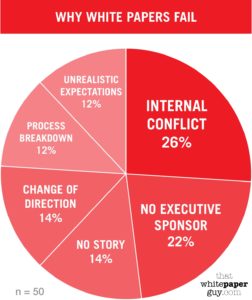
Why do some white papers fail?
Unfortunately, some white papers fail to generate the business results their sponsors hope for.
In my experience, a white paper can fail in two main ways.
Fail #1: A white paper may never be completed
Many white papers are started, but not all are finished.
And this happens far too often.
At That White Paper Guy, we recently analyzed 300 of our own white paper projects going back to 1997.
Our research revealed that 50 of these white papers—1 in 6 (17%)—were never completed nor published.
Nearly all of these (47 out of 50, or 94%) were abandoned by the client, not the writer.
The main reasons for these failures are shown in the pie chart and summed up below.
Internal conflict: Doing a white paper can reveal a split between two teams who just can’t agree.
No executive sponsor: The white paper champion can leave, get promoted, or be pulled away to other duties. With no champion, a paper can die on the vine.
No story: There may be no evidence to support the white paper’s argument.
Change of direction: A team can decide to go in a new direction, sometimes when a product is delayed or canceled.
Process breakdown: The publishing process can simply break down. This happens most often during reviews. Perhaps some reviewers can’t articulate their views about a draft. Or perhaps some reviewers disagree and can’t resolve their differences.
Unrealistic expectations: A white paper can be doomed by unrealistic expectations about the effort involved or the likely return on that effort.
All these except “no story” are problems with project management… on the client’s side. For example:
- No outside writer can compel reviewers to hash out their differences
- No outside writer can change the priorities set by an employee’s manager
- No outside writer can set proper expectations if the client doesn’t listen
Note that several other sources agree off the record with these conclusions. Several have stated that their own failure rate was much higher than 1 in 6.
For a longer discussion of this topic, see my article “6 reasons why white papers fail: our data and stories.”
Fail #2: A white paper may not be promoted effectively
One earlier answer lists 18 must-do promotions that every marketing team should do for every white paper. Yet not everyone does all these.
As well, some further optional promotions can be done.
Without covering all these bases, few target readers will hear about the white paper, and its reach will be far smaller than it could have been.
Fewer readers lead to fewer conversations and lesser business results.
Why are some white papers “challenged”?
Unfortunately, some white papers are published with serious defects that reflect poorly on the sponsor.
These defects could be in the content (research and writing) or the format (design and graphics).
I consider this type of white paper to be “challenged.”
At That White Paper Guy, we recently analyzed 300 of our own white paper projects going back to 1997.
Our research revealed that 36 of these white papers—about 1 in 9 (11%)—did not turn out as well as they could have.
Those papers were challenged by flaws in the content, design, or publishing process.
I’m not talking about the occasional typo.
I’m talking about problems serious enough that the white paper will not likely attract its target readers nor generate the expected business results.
There were half a dozen main reasons for this, as shown in the pie chart.
Please note that the “lack of editorial or design skills” existed on the client’s side.
For example, sometimes a client assured us they have a competent designer to handle the formatting of the paper.
But the results fell far short of professional standards for typography, page design, or illustration.
For a longer discussion of this topic, see my article “5 reasons why white papers are challenged: our data and stories.”
White papers past, present, and future
Where did white papers come from?
The term “white paper” arose late in the 19th century in Great Britain.
It was used to distinguish shorter government briefings and position papers with white covers from longer reports and policy books with blue covers.
I have located white papers from the UK dating back to the late 1890s. I am still searching for the earliest one on file in the UK government archives.
(My research was interrupted by Covid staff shortages in the UK.)

One example that many people point to is the Churchill White Paper from 1922.
While this is far from the earliest white paper ever published, it did touch on a topic that’s still relevant today: the territorial ambitions of various groups in the Middle East.
Months after it appeared, Britain apparently broke every promise in it.
So just like today, not all white papers speak the truth?!
White papers were used in science and medicine during WWII and the 1950s.
This continued until the widespread adoption of the PC and the expansion of commercial software in the 1980s.
Ever since then, white papers have been popular in the IT industry.
And in the 1990s, the Web provided an inexpensive distribution channel that sparked the explosion of white papers over the past 30 years.
Where are white papers today?
The number of white papers is growing exponentially.
And here’s proof.
In 2002, I ran a Google search for the phrase “white papers” that yielded 2.8 million hits.
A decade later in 2012, the same search got 39.5 million hits: 14 times as many.
Twenty years later in 2022, the same search yielded 782 million hits: more than 50 times as many as a decade earlier…. and 279 times as many as 20 years ago.
Here’s another data point. Over the past 10 years, the annual surveys by the Content Marketing Institute have found that white papers are used by an average of 6 out of 10 of B2B marketers surveyed.
I think we can all agree that the Web is awash in documents called “white papers.” In many sectors, these are a standard part of the marketing toolkit.
That’s because truly effective white papers get results. They get seen by B2B decision-makers and passed around buying committees.
White papers help drive purchases worth billions of dollars worth of products and services every year.
But there’s one problem…
This label is applied indiscriminately to documents that are nothing but thinly veiled sales pitches.
For this reason, the term “white paper” risks becoming devalued.
It may be better to use a different name, such as:
- Executive briefing
- Guide
- Handbook
- Research report
- ROI calculator
- Special report
- Technology backgrounder
Both the 2022 and 2023 Netline reports on content consumption found that B2B readers, even in IT, preferred to download documents called “ebooks” or “guides” far more often than plain old white papers.
For more discussion, see my newsletters for April 2022 and for April 12, 2024.
Where are white papers going in the future?
White papers will likely continue to be popular with B2B marketers and prospects.
Yet many new formats for delivering information are being explored.
For the kinds of content in a white paper, these new formats include:
- Audios and podcasts
- Explainer videos
- Microsites
- Recorded webinars
Other mediums on the horizon include 3D immersive experiences (aka the metaverse) and virtual trade shows. Other new mediums will no doubt be invented as well.
Although these formats can offer a more engaging experience than simply reading, they usually require higher budgets, more skills, and sophisticated production.
A few companies have published materials they dubbed “video white papers.” But it’s not useful to call these “white papers” since they are not delivered as narrative text in a printable format.
Those who call some other medium a “white paper” are simply trying to trade off the popularity and impact of these documents.
For a longer discussion, see my article “When is a white paper NOT a white paper?”

Won’t all white paper writers soon be replaced by AI?
White papers are challenging projects that require a subtle combination of writing to explain and writing to persuade.
That makes these documents the last projects that AI will likely be able to handle.
AI writing tools like ChatGPT are best for creating writeups of events with prescribed outcomes like sports events or the stock market.
After all, if a Little League team wins a baseball game, it doesn’t take a post-graduate degree in journalism to write that up.
If a stock goes down by 5% it doesn’t take “a brain the size of a planet” to write about that.
Prediction: As long as any business person anywhere still needs to understand an issue, solve a problem, or make a decision, they will need some sort of information package analogous to a white paper.
And it will most likely be human beings who assemble this information.
So the skills people develop working on white papers will be in demand for a long, long time.
For a longer discussion, see my article “Will AI replace white paper writers?”
If you have any questions about white papers that aren’t answered here, or you find an answer that isn’t clear, please e-mail Gordon at That WhitePaperGuy.com
I’ll do my best to answer.
Originally published: August 2005. Last updated: 14 April 2024.


